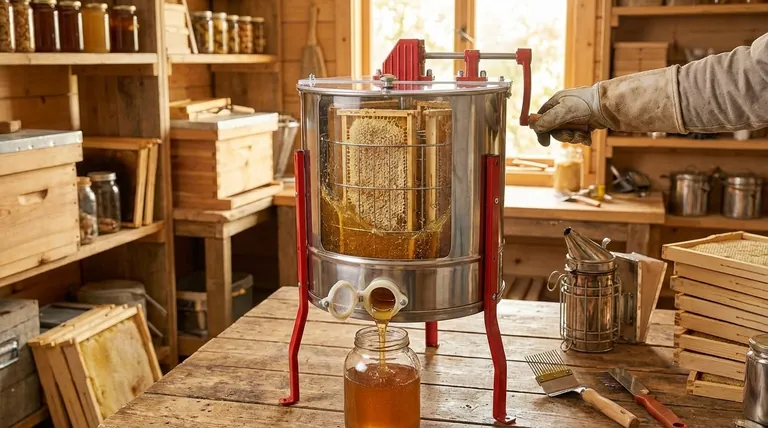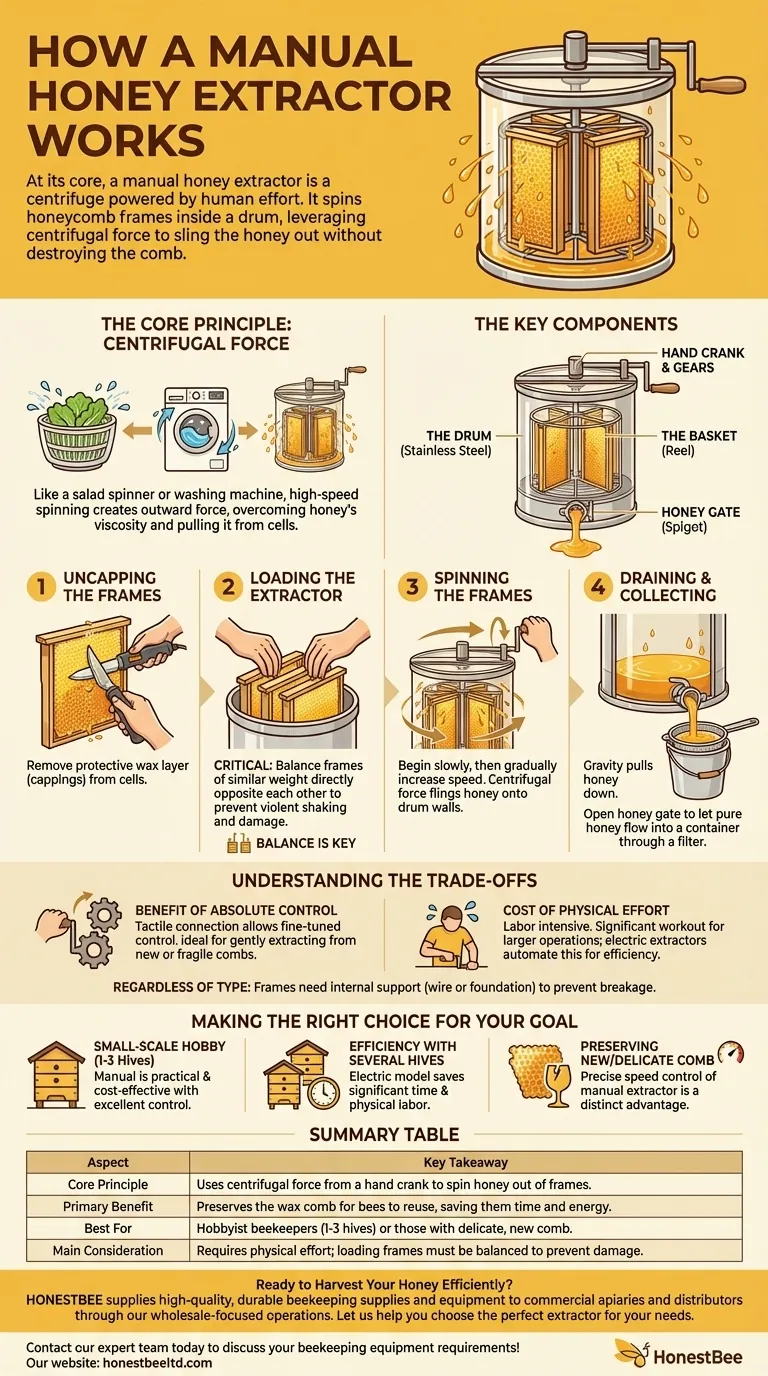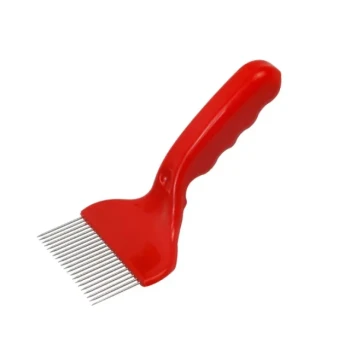At its core, a manual honey extractor is a centrifuge powered by human effort. It uses a hand crank to spin honeycomb frames inside a large drum, leveraging centrifugal force to sling the honey out of the wax cells without destroying the comb. This allows beekeepers to harvest the honey while preserving the comb structure for the bees to reuse.
The entire device is engineered for a single, elegant purpose: to separate liquid honey from its solid wax comb gently and efficiently. The manual crank is the key, putting you in direct control of a powerful physical force to ensure the delicate comb remains intact.

The Core Principle: Centrifugal Force
A honey extractor operates on the same principle as a salad spinner flinging water from lettuce or a washing machine’s spin cycle removing water from clothes. By spinning the frames at high speed, it creates an outward force that overcomes the honey's viscosity, pulling it from the individual cells.
The Key Components
A manual extractor is a simple machine with four primary parts that work in concert:
- The Drum: This is the large, cylindrical container, typically made of stainless steel, that houses the operation and collects the honey.
- The Basket (or Reel): An internal cage designed to hold the honey frames securely as they spin.
- The Hand Crank and Gears: This mechanism sits on top. Turning the crank spins a set of gears that rapidly rotate the central rod connected to the basket.
- The Honey Gate: A tap or spigot at the bottom of the drum that allows you to drain the collected honey after extraction.
The Step-by-Step Extraction Process
Simply placing frames in the extractor is not enough. The process begins with careful preparation to ensure a successful harvest.
Step 1: Uncapping the Frames
Before honey can be extracted, you must remove the protective wax layer the bees build over each filled cell. This is known as uncapping.
This is typically done with a heated electric knife or a specialized uncapping fork. These wax cappings are valuable and can be saved for rendering into beeswax later.
Step 2: Loading the Extractor
The uncapped frames are placed vertically into the slots in the basket.
The most critical factor here is balance. You must load frames of similar weight directly opposite each other to prevent the extractor from shaking violently, which can damage the machine, the floor, and the combs.
Step 3: Spinning the Frames
Begin turning the hand crank slowly, then gradually increase the speed. Starting slowly is crucial, especially with delicate combs, as a sudden burst of force can shatter them.
As the basket spins, honey is flung from the cells onto the inner wall of the drum.
Step 4: Draining and Collecting
Gravity pulls the extracted honey down the drum's walls, where it pools at the bottom.
Once the process is complete, you can open the honey gate and let the pure, liquid honey flow out into a container, often through a filter or strainer to remove any bits of wax.
Understanding the Trade-offs
While the principle is the same, choosing a manual extractor over an electric one involves specific considerations.
The Benefit of Absolute Control
A manual crank gives you a tactile connection to the process. You can feel the resistance and adjust your speed second by second.
This fine-tuned control is ideal for gently extracting honey from new or fragile combs that might be damaged by the fixed, high speeds of some electric models.
The Cost of Physical Effort
The primary drawback is the labor involved. Extracting honey from more than a few hives with a manual crank is a significant physical workout.
Electric extractors automate this step, saving enormous amounts of time and energy for beekeepers with larger operations.
The Need for a Strong Foundation
Regardless of the type of extractor, the force involved is immense.
Frames must have internal support, such as wire or a plastic foundation, to keep the comb from breaking apart during spinning. Using foundationless frames in an extractor is extremely risky and often results in a shattered mess.
Making the Right Choice for Your Goal
Selecting an extractor depends entirely on the scale of your beekeeping and your personal goals.
- If your primary focus is a small-scale hobby (1-3 hives): A manual extractor is the most practical and cost-effective choice, offering excellent control without a large investment.
- If your primary focus is efficiency with several hives: An electric model will save you significant time and physical labor, making the harvest process much faster and more manageable.
- If your primary focus is preserving new or delicate comb: The precise speed control of a manual extractor is a distinct advantage, allowing you to start slowly and prevent comb "blowouts."
Ultimately, a manual extractor works by translating your physical effort into a powerful natural force, connecting you directly to the final, rewarding step of the honey harvest.
Summary Table:
| Aspect | Key Takeaway |
|---|---|
| Core Principle | Uses centrifugal force from a hand crank to spin honey out of frames. |
| Primary Benefit | Preserves the wax comb for bees to reuse, saving them time and energy. |
| Best For | Hobbyist beekeepers with 1-3 hives or those working with delicate, new comb. |
| Main Consideration | Requires physical effort; loading frames must be balanced to prevent damage. |
Ready to Harvest Your Honey Efficiently?
Whether you're a hobbyist or a commercial beekeeper, having the right equipment is crucial for a successful harvest. HONESTBEE supplies high-quality, durable beekeeping supplies and equipment to commercial apiaries and beekeeping equipment distributors through our wholesale-focused operations.
Let us help you choose the perfect extractor for your needs.
Contact our expert team today to discuss your beekeeping equipment requirements!
Visual Guide

Related Products
- Stainless Steel 3 Frame Manual Honey Extractor Spinner for Bee Honey Extraction
- HONESTBEE 3-Frame Manual Acrylic Honey Extractor
- 6 Frame Manual Stainless Steel Honey Extractor Beekeeping Equipment
- 2 Frame Stainless Steel Manual Honey Spinner Extractor for Beekeeping
- Plastic Hand Crank 2 Frame Honey Extractor Low Price
People Also Ask
- How to extract honey by hand? A Guide to Crush & Strain vs. Manual Extractors
- Which type of honey extractor is generally more durable? Focus on Material & Build Quality for Longevity
- What is a fun and easy alternative to using a honey extractor for harvesting honey? Try the Crush and Strain Method
- How do you manually extract honey? Choose the Best Method for Your Hive
- What happens to wired frames after honey extraction? Maximize Apiary Efficiency & Bee Health



















